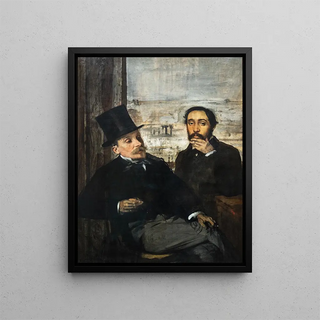Painting Degas and Évariste de Valernes - Edgar Degas | Art print


View from behind

Frame (optional)
Degas and Évariste de Valernes Art print - Edgar Degas – Captivating Introduction
In the vibrant world of Impressionist art, the work "Degas and Évariste de Valernes" stands as a poignant testament to the intersection of art and life. Edgar Degas, an iconic figure of this movement, immerses us in an intimate scene where dance, light, and the psychology of characters intertwine with unmatched delicacy. This painting, both lively and melancholic, evokes the world of Parisian spectacles while revealing the subtleties of human nature. Through this piece, Degas invites us to explore the emotions hidden behind each gesture, each gaze, offering a unique approach to artistic representation.
Style and uniqueness of the work
The stylistic richness of "Degas and Évariste de Valernes" manifests in the mastery of colors and movements. Degas, faithful to his penchant for motion, captures the fleeting moment of a dancer, while incorporating a secondary character, Évariste de Valernes, who appears to observe with a mixture of admiration and curiosity. The dynamic composition, where lines and shapes intertwine, creates a palpable tension, revealing rare emotional depth. The play of light and shadow, characteristic of Degas's work, enhances the three-dimensionality of the figures, making them almost alive. The pastel technique, often used by the artist, gives the work a soft, velvety texture, allowing viewers to feel the lightness and grace of the dancers' movements.
The artist and his influence
Edgar Degas, born in 1834, is often regarded as one of the pioneers of Impressionism, although he always maintained a personal and distinct approach. His fascination with ballet and scenes of Parisian life profoundly marked his work, making him a keen observer of the nuances of the human condition. Influenced by masters such as Ingres and Manet, Degas developed a style that combines academic rigor with innovation. His unique approach to perspective and framing, inspired by photography and Japonism, opened new paths in modern art. By exploring themes such as the

Matte finish

View from behind

Frame (optional)
Degas and Évariste de Valernes Art print - Edgar Degas – Captivating Introduction
In the vibrant world of Impressionist art, the work "Degas and Évariste de Valernes" stands as a poignant testament to the intersection of art and life. Edgar Degas, an iconic figure of this movement, immerses us in an intimate scene where dance, light, and the psychology of characters intertwine with unmatched delicacy. This painting, both lively and melancholic, evokes the world of Parisian spectacles while revealing the subtleties of human nature. Through this piece, Degas invites us to explore the emotions hidden behind each gesture, each gaze, offering a unique approach to artistic representation.
Style and uniqueness of the work
The stylistic richness of "Degas and Évariste de Valernes" manifests in the mastery of colors and movements. Degas, faithful to his penchant for motion, captures the fleeting moment of a dancer, while incorporating a secondary character, Évariste de Valernes, who appears to observe with a mixture of admiration and curiosity. The dynamic composition, where lines and shapes intertwine, creates a palpable tension, revealing rare emotional depth. The play of light and shadow, characteristic of Degas's work, enhances the three-dimensionality of the figures, making them almost alive. The pastel technique, often used by the artist, gives the work a soft, velvety texture, allowing viewers to feel the lightness and grace of the dancers' movements.
The artist and his influence
Edgar Degas, born in 1834, is often regarded as one of the pioneers of Impressionism, although he always maintained a personal and distinct approach. His fascination with ballet and scenes of Parisian life profoundly marked his work, making him a keen observer of the nuances of the human condition. Influenced by masters such as Ingres and Manet, Degas developed a style that combines academic rigor with innovation. His unique approach to perspective and framing, inspired by photography and Japonism, opened new paths in modern art. By exploring themes such as the
12,34 €






